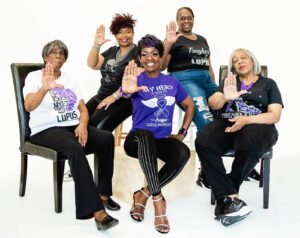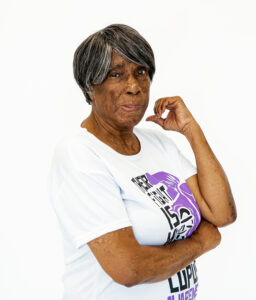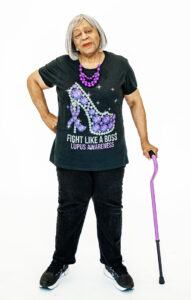 Sojourner’s Truth Staff
Sojourner’s Truth Staff
What exactly is lupus? Lupus is different things to different people in the affect on their lives but essentially it is for everyone a chronic health condition that lasts a long time and that currently has no cure.
It is a disease that involves the immune system and can damage any part of the body. The immune system is like a bodyguard against invaders, such as viruses, bacteria, and other germs. Normally, a part of the immune system works to fight off these invaders by making antibodies – molecules in the body that, when working correctly, protect the body from foreign invaders such as viruses and bacteria.
However, in the case of lupus, the immune system can’t tell the difference between the invaders and the body’s own healthy tissue. It creates autoantibodies – antibodies that destroy the body’s own healthy cells, which can cause inflammation and organ damage. that attack and destroy the healthy tissue, causing inflammation.
Over five million people around the world have some form of lupus. While anyone can suffer from lupus:
- Women ages 15–44 are most likely to develop lupus. In fact, lupus occurs 9 out of 10 times more often in women than in men.
- Women of color, including African American, Asian, Hispanic/Latina, Native American, and Pacific Islander women, are also more likely to develop lupus compared with Caucasian women.
- People who have a family member with lupus or another autoimmune disease are more at risk

Rachelle Roy, organizer of the Toledo area effort to bring awareness to lupus, was diagnosed with discoid lupus in 2005. She suffers from discoid, or cutaneous, lupus which primarily affects the face and results in frequent outbreaks and inflammation. A Scott High School graduate who attended Bowling Green State University and has been a letter carrier for 25 years, she first experienced a skin rash in her early 30’s – a skin rash that was not properly diagnosed in the initial stages. That early stage appeared as an acne breakout and the medicine prescribed was ineffective.
She quietly lived with the discomfort and the loss of self-esteem for years before accepting her fate and deciding that it was time to do something about the public’s indifference to the disease.
“I’ve been wanting to do a walk for many, many years,” she said. “I had been getting perturbed about a lack of attention lupus has been getting, so it made me reach out.”
And so she did. She organized the first Living With Lupus Walk last year and followed up with an entire weekend this year – parade, bowling, walk – this year.
And, she brought together other lupus sufferers for this photo shoot.
Brenda Brooks was diagnosed with lupus in 2009 but it took a while for doctors to reach a conclusion. Brooks was working at the University of Toledo Medical Center’s Dana Cancer Center in a job that required a lot of standing on concrete floors. Over time her legs became and remained swollen with “red hot pain.”
Typically, the diagnosis was not easily forthcoming – fibromyalgia was the first suspect. The intense pain in her legs and hands continued until a rheumatologist correctly diagnosed the problem and she was medicated for lupus.

Today she is on “a lot of medication” and although it helps to a degree, the pain has not nearly disappeared.
Tymeeka Gipson was diagnosed with lupus in 1997 and, unlike many other victims, has virtually all types of lupus and all kinds of symptoms. She has systemic lupus erythematosus, discoid lupus erythematosus and lupus nephritis.
She has experienced the facial skin outbreaks, kidney issues and heart problems. While she has not undergone surgeries, she has spent “a significant time in hospitals,” particularly for her heart issues.
Barbara Howard was diagnosed with lupus relatively late in life and only two years ago, after perhaps six years of experiencing pain in her joints.
Asked what type of lupus she has been diagnosed with, she replied “the pain kind – nothing but pain.”
As she sought understand and find relief, she saw numerous doctors and specialists who were not able to provide answers for so long – some thought she might be suffering from multiple sclerosis (MS).
Now Howard still suffers “most of the time” if not as much as before the diagnosis.
If Howard, who was diagnosed relatively late in life with lupus, represents one extreme of the diagnosis spectrum, Joyce E. Goings certainly represents the other – the longevity extreme.
Goings, 80 years old, has been suffering from lupus for 41 years – that is she was diagnosed 41 years ago. Goings suffers from discoid lupus as does Roy. And for her, there are only two primary ways of coping with the ongoing pain and discomfort “keep a positive attitude and keep doctors appointments.”





